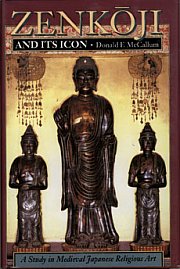|
JAPAN'S OLDEST BUDDHA STATUES
The Hidden Buddha of Zenkōji Temple
Zenkōji (Zenkoji) Temple 善光寺 in Nagano Prefecture
This is a Side Page
Return to Parent Page on Drapery
Return to Parent Page on Early Japanese Buddhism
The central images at Zenkōji Temple 善光寺 are reportedly the first Buddhist images ever brought to Japan. They came from the 6th-century Korean Kingdom of Kudara (百済, aka Paekche, Paekje, Paikche, Baekje), and became secret images in +654 (not shown to the public). The occasion on which the Maedachi Honzon 前立本尊, a duplicate of the original main image, is taken out of the treasure house and displayed to the public in the Main Hall once every seven years is called the Gokaichō (Gokaicho) 御開帳. This temple has not belonged to any Buddhist sect and has been widely popular among all walks of people. It has been particularly famous for having accepted female pilgrims since old times. <Source: This Site>
|

Amida Triad, +552, 善光寺の阿弥陀三尊
Ikkō Sanzon Amida 一光三尊阿弥陀, Guilt Bronze
This Amida Triad is the main devotional object at Zenkōji Temple 善光寺 in Nagano Prefecture. It reportedly was made in India, then traveled to China, and was brought to Japan by Hata no Kosedayuu 秦巨勢大夫 in +552. The central Amida Nyorai statue is flanked by Kannon Bosatsu (who personifies compassion) and Seishi Bosatsu (who personifies wisdom).
Photo From This Web Site. Donald F. McCallum, Professor of Art History, UCLA, 405 Hilgard Avenue, 100 Dodd Hall, Los Angeles CA 90025-1417. This photo is the dust jacket to Zenkōji and Its Icon: A Study in Medieval Japanese Religious Art by Donald F. McCallum.

|
|
Says the Washington Post: People come to pass through the pitch-black hallway that houses the famous golden triad, which is known as the Ikkō (Ikko) Sanzon Amida Nyorai 一光三尊阿弥陀三尊 and is considered the first Buddhist image ever to enter Japan (it arrived from Korea in +552). The image is never shown to the public; instead, visitors are requested to remove their shoes and descend a staircase into total darkness, then make their way down a twisted hallway with only the touch of their fingertips on the rough walls as a guide. The tunnel is beneath the altar that holds the triad, and there is a sense of near-total sensory deprivation as visitors make their way through blackness, hoping that their fingertips will brush the lock that graces the wall directly beneath the image. Those who touch the lock are said to be guaranteed a place in paradise. <end quote from Washington Post>

Says JAANUS: Zenkōji-shiki Amida Sanzonzō 善光寺式阿弥陀三尊像. Images of the Amida Triad 阿弥陀三尊 made in the style of the Amida trinity at Zenkōji (Zenkoji) Temple 善光寺 in Nagano prefecture. This triad is the principal devotional image at Zenkōji and is said to have originated in India. It then traveled to China, and was brought to Japan by Hata no Kosedayu (Kosedayū) 秦巨勢大夫 in +552. It is a triad of Amida Buddha with the attendants Kannon 観音 and Seishi Bosatsu 勢至菩薩 rendered in gilt bronze. The main figure and the two attendants are placed against the same nimbus (see Ikkō Sanzon 一光三尊 below). The standing Amida image is shown with the right hand raised and the left hand lowered in the position known as Token-in (Tōken-in) 刀剣印 or To-in (Tō-in) 刀印, where only the forefinger and middle finger are extended. The attendant figures wear ornamental crowns and have their hands folded across their chest. In the Fujiwara and Kamakura periods, Pure Land Buddhism, Jodokyo (Jōdokyō) 浄土教, spread in Japan and faith in the Amida Buddha became very widespread. A large number of imitations of the Zenkōji-jishiki Amida Sanzon were made, initially in the Kanto (Kantō) 関東 and Tohoku (Tōhoku) 東北 areas and later throughout the country. Many of these statues were made of bronze, and some were gold plated. There are also rare examples of wooden or iron statues. Although the size of the images varied, the central figure was most frequently around 30-cm in height. The Zenkōjishiki Amida Sanzon at Zenkōji Temple in Yamanashi Prefecture is the oldest signed example in Japan, bearing the date +1196 (Kenkyū 建久 7). <end JAANUS quote>
Ikkō (Ikko) Sanzon 一光三尊. Text courtesy JAANUS. A triad of Buddhist statues arranged in front of a large nimbus (Kōhai 光背), that framed all three statues from head to toe (Kyoshinkō 挙身光). The nimbus is usually in the shape of a lotus petal, and each attendant often also has its own head-halo (Zukō 頭光). This iconic type originated in China. The Shaka Triad, Shaka Sansonzō 釈迦三尊像 at Hōryūji Temple 法隆寺 is a typical Japanese example dating from the Asuka period. Amida Triads in the Zenkoji style (Zenkōjishiki Amida Sanzonzō 善光寺式阿弥陀三尊像) followed this form in later periods. <end JAANUS quote>

|